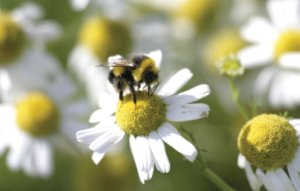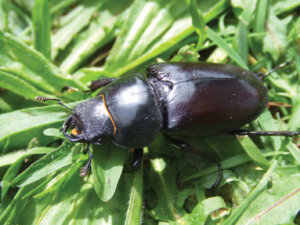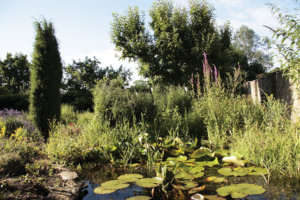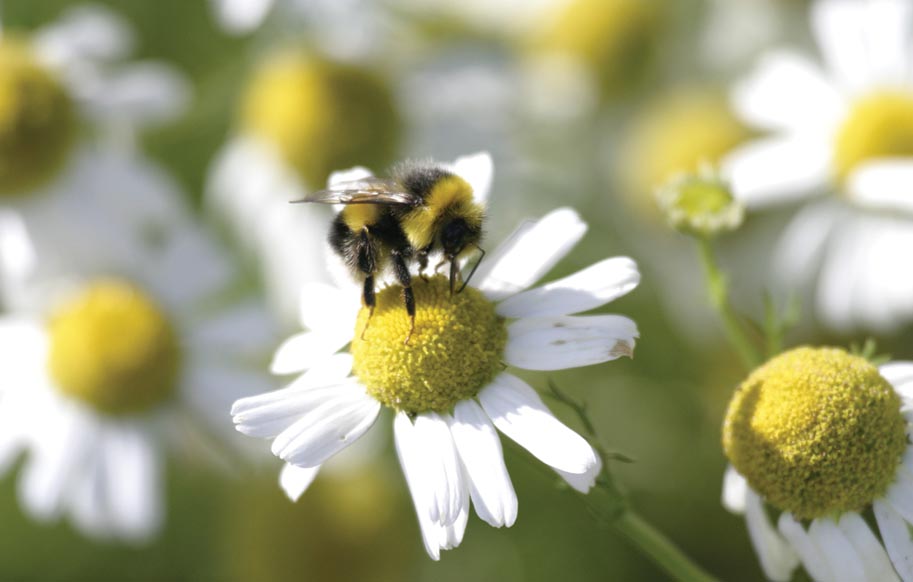 OK, spring has arrived and you may feel the time is ripe for getting to grips with your garden. All around you, however, smaller occupants of the garden are trying frantically to find food, avoid being something else’s lunch or trying to reproduce. As well as being incredibly interesting in themselves, many are in fact rather spectacular, invertebrates have a key role in every aspect of garden life. Invertebrates pollinate flowers, recycle nutrients by breaking down dead plant material which in turn improves the soil they keep populations of other invertebrates in natural balance. In addition to all of these important functions they are the basis of a food web that ultimately feeds the majority of our garden birdlife. All those tits and sparrows that you have diligently fed throughout the winter raise their young on a diet of small creatures. The message is clear, if you want your garden to teem with life, look after it’s smallest occupants.
OK, spring has arrived and you may feel the time is ripe for getting to grips with your garden. All around you, however, smaller occupants of the garden are trying frantically to find food, avoid being something else’s lunch or trying to reproduce. As well as being incredibly interesting in themselves, many are in fact rather spectacular, invertebrates have a key role in every aspect of garden life. Invertebrates pollinate flowers, recycle nutrients by breaking down dead plant material which in turn improves the soil they keep populations of other invertebrates in natural balance. In addition to all of these important functions they are the basis of a food web that ultimately feeds the majority of our garden birdlife. All those tits and sparrows that you have diligently fed throughout the winter raise their young on a diet of small creatures. The message is clear, if you want your garden to teem with life, look after it’s smallest occupants.
The great thing about invertebrates is that small changes to your garden can greatly improve the conditions for them to thrive. Below are 12 easy tips to benefit bugs:
Create a log pile. Select a quiet area of you garden and place logs in an irregular pile. Log piles are great for beetles, slugs, centipedes and millipedes. They also provide over wintering and hunting habitats for newts, so a log pile by a pond is particularly beneficial. Taking it a step further large partially buried wood may provide a home for the Lesser Stag beetle, the wood will need to be left for a minimum of seven years. Log piles are best if built with native hardwood such as oak, birch or ash.
Install a pond in the autumn. Ponds bring a completely different dimension to a garden. Dragonflies and damsel flies will colonise a well built pond within the first year and it will provide an additional habitat a vast range of creatures. If you already have a pond try to keep summer management to a minimum. If you do need to extract weed leave it lying beside the pond for a day or two to allow its inhabitants to return to the water.
 Plant lots of nectar sources. Butterflies, moths and bees require nectar sources throughout the summer so try to plant flowers that will provide a continuous supply from early summer to late autumn.
Plant lots of nectar sources. Butterflies, moths and bees require nectar sources throughout the summer so try to plant flowers that will provide a continuous supply from early summer to late autumn.
Find a corner for nettles. A patch of nettles particularly if it is in a sunny spot provides the ideal habitat for the caterpillars of the peacock and small tortoiseshell butterflies. If you have the room, a patch of brambles provides flowers in the summer and berries in the autumn both excellent sources of food.
Learn to love wasps. Despite their role as the pantomime villain of the garden, wasps provide a valuable service. They are voracious predators and help keep populations of some problem species in check.
Try more natural forms of pest control. Instead of throwing chemicals at problems try encouraging beneficial insects into your garden. Lacewings and hoverflies will keep aphid numbers under control and can be encouraged into your garden by installing nest boxes and reducing use of chemicals.
Leave some seed heads uncut. Many insects over winter in the dead seed heads and stems of flowering plants. Try leaving some uncut this autumn, birds such as the goldfinch and house sparrow will also benefit. An un-mown area of lawn will also provide an excellent winter home.
Create a native wildflower meadow. Not an easy option, meadows require lots of work but the benefits of native wildflower meadow for insect life are huge. Once established a meadow full of knapweed and scabious will be buzzing with life throughout the summer.
Living in the shadows. If your garden is very hot many small creatures will struggle to survive, use your planting scheme to create a shady corner. Many creatures will be helped by something as small as a broken plant pot or an old roof tile positioned to provide shade.
Compost. Compost heaps are warm and moist ideal conditions for invertebrates to thrive. If you don’t fancy making a compost heap allow fallen leaves to breakdown naturally, they’re all food and homes for something.
Leave Ivy intact. Take a look at Ivy at the end of the summer and it will be covered with insects. Ivy is an excellent late season nectar source and provides cover for birds and bats as well as invertebrates. Ivy is also the food plant for the second brood of the Holly Blue, a butterfly whose populations are susceptible to massive annual fluctuations.
Forget about wind blown fruit. If you have a few fruit trees in the garden leave the windblown apples to rot, great food for birds as well as bugs.
We also know that some invertebrates arrive unaided and more due to careless importation, especially of garden plants and agricultural produce. They survive either because they out compete native species or occupy new niches, perhaps provided by us or due to changing climate. Some examples are:
Harlequin Ladybird
Truly an invader, described as “the world’s most invasive ladybird” it has been introduced from its native area in E. Asia to much of the world. It arrived in N. America in 1988 and is now the most widespread species there! It got to the UK in 2004 and has already spread across SE England, including the Island. It is a predator and competitor for our native species and definitely not a positive addition to our fauna. They could turn up anywhere and probably will, the spread is being monitored and new records are always wanted.
Bombus Hypnorum
A bumble-bee newly arrived under its’ own steam from over the channel and probably surviving due to climatic warming. It has not got a common name yet – its scientific name means ‘sleepy bee’- but looks like a white tailed version of the familiar ginger furred Common Carder Bee. Gardens with their abundance of flowers are particularly important for bumble-bees, grow flowers that provide lots of nectar and pollen and hear the buzz.
 Cypress Carpet
Cypress Carpet
Probably arrived here by flying across the channel but definitely only staying because of gardens. This small moth flying from late summer actually likes leylandii hedges! The caterpillars only eat this and similar introduced species and so are only here because of our gardens. The Isle of Wight is one of its British strongholds of this species but it is likely to spread.
Small Red-eyed Damselfly
Having spread north and west in Europe the channel proved no obstacle to this species which first arrived in Essex in 1999 and is now firmly established on the Isle of Wight. They like ponds with floating vegetation, even just algae and will breed in much smaller ponds than their relative the Large Red-eyed Damselfly, which likes larger and much deeper ponds or lakes, especially with water-lilies. Look out for them at your pond from about July onwards into the autumn.



